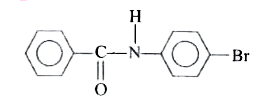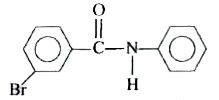Cumene KMnO4−−−−−−−→BoilAPCl5−−→BC−−→ Benzaldehyde
Find "C" :
H2/Pd/BaSO4
CO/HCl/ AlCl3
CH3NH2/HCl/AlCl3
CrO3/Ac2O
The correct Answer is:A
To solve the problem step by step, we will analyze the transformations of cumene to benzaldehyde through the various reagents mentioned.
Step 1: Identify the starting compound
- Starting compound: Cumene (isopropyl benzene), which has the structure:
C6H5C(CH3)2
Step 2: Reaction with KMnO4
- Reagent: KMnO4 (potassium permanganate) in a boiling condition.
- Reaction: This reagent is a strong oxidizing agent. When cumene is treated with KMnO4, it undergoes oxidation to form benzoic acid.
- Product A: Benzoic acid (C6H5COOH).
Step 3: Reaction with PCl5
- Reagent: PCl5 (phosphorus pentachloride).
- Reaction: Benzoic acid reacts with PCl5 to form benzoyl chloride (an acid chloride).
- Product B: Benzoyl chloride (C6H5C(O)Cl).
Step 4: Conversion of benzoyl chloride to benzaldehyde
- Reagent: The conversion of benzoyl chloride to benzaldehyde typically involves a reduction process.
- Reduction Method: The Rosenmund reduction is used here, which involves the use of hydrogen gas (H2) in the presence of a palladium catalyst supported on barium sulfate (BaSO4).
- Product C: Benzaldehyde (C6H5CHO).
Conclusion
- The compound "C" that is used in the reduction of benzoyl chloride to benzaldehyde is:
- C: H2 in the presence of Pd/BaSO4 (palladium on barium sulfate).
Final Answer
- C: H2 with Pd/BaSO4
---
- Starting compound: Cumene (isopropyl benzene), which has the structure:
C6H5C(CH3)2
- Reagent: KMnO4 (potassium permanganate) in a boiling condition.
- Reaction: This reagent is a strong oxidizing agent. When cumene is treated with KMnO4, it undergoes oxidation to form benzoic acid.
- Product A: Benzoic acid (C6H5COOH).
- Reagent: PCl5 (phosphorus pentachloride).
- Reaction: Benzoic acid reacts with PCl5 to form benzoyl chloride (an acid chloride).
- Product B: Benzoyl chloride (C6H5C(O)Cl).
- Reagent: The conversion of benzoyl chloride to benzaldehyde typically involves a reduction process.
- Reduction Method: The Rosenmund reduction is used here, which involves the use of hydrogen gas (H2) in the presence of a palladium catalyst supported on barium sulfate (BaSO4).
- Product C: Benzaldehyde (C6H5CHO).
- The compound "C" that is used in the reduction of benzoyl chloride to benzaldehyde is:
- C: H2 in the presence of Pd/BaSO4 (palladium on barium sulfate).
- C: H2 with Pd/BaSO4
Topper's Solved these Questions
Similar Questions
Knowledge Check
The final product (C) of the following reaction would be:
C6H5−C∣∣O−C6H5H2N−OH−−−−−−→APCl5−−→BBr2/Fe−−−−→C+A B
B C
C D
D
Identify (X), (Y) andc (Z) in the given reaction :
CH3CHOK2Cr2O7−−−−−→H2SO4(X)PCl5−−→(Y)C6H6−−−−−→anh.AlCl3(Z)A(X)=HCOOH,(Y)=COCl2,(Y)=COCl2,(Z)=C6H5ClB(X)=CH3COOH,(Y)=CH3COCl,(Z)=C6H5COCH3C(X)=CH3COOH,(Y)=CH3CH2CH2Cl,(Z)=C6H5CH2CH2CH3D(X)=CH3COCH3,(Y)=CH3CHClCH3,(Z)=C6H5COCH3
H3C−COOHP2O5−−−−−→ΔAPCl5−−→BC6H6−−−−−→AlCl3C, C is-
View SolutionIn the following reaction sequence ,
Ethyl amine HNO2−−−→APCl5−−→BNH3−−→C the compound C is
View SolutionIn the reaction
CH3COOHPCl5−−→(A)NH3−−→(B)NaBrO−−−→(C)
the final product (C) is:
View SolutionRCOOHPCl5−−→AH2−−−−→CalalystBH2−−−−→CatalystCPBr3−−→DKCN−−→EH+−−→H2OF
View SolutionH3C−O∣∣C−NH2PCl5−−→ALiAiH4−−−−−−→H2OB
Final product B is
View SolutionPh−CH3KMnO4−−−−→ΔASoda Lime−−−−−→ΔB
Compound B is :
View Solution

